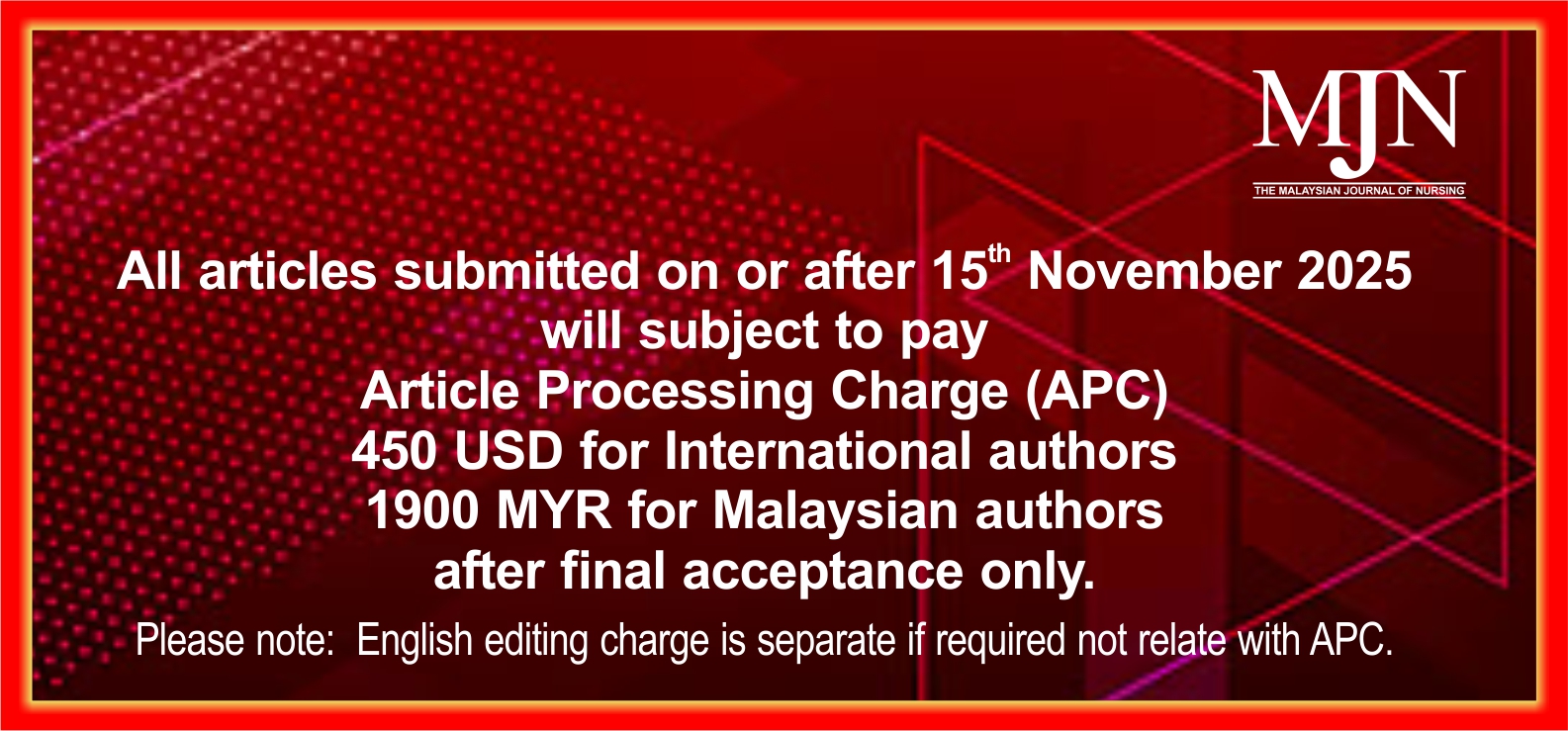Ways of Coping and Mental Health among Nursing Students Transitioning from Online Learning to In-Person Classes in a University Setting
DOI:
https://doi.org/10.31674/mjn.2023.v15i01.008Abstract
Background: Education is one of the sectors where the COVID-19 pandemic has had the biggest impact. Schools all throughout the world had to make adjustments, and after many years, virtual learning is now transitioning back to traditional in-person learning. During the Pandemic, concerns about mental and psychological health are becoming increasingly prevalent, especially among university students. Objective: The purpose of this study is to analyze the impact of shifting from online or virtual classrooms to in-person classes on nursing students' mental health and coping strategies. Methods: A cross-sectional and descriptive-correlational research design with a survey questionnaire was used among 405 nursing students from Mindanao State University's College of Health Sciences to determine how nursing students adjust to returning to school after more than two years of taking online classes due to pandemic restrictions. Results: The study revealed that the students' psychological well-being was much higher than their emotional and social well-being. This study's findings demonstrated a substantial positive correlation between nursing students' proactive coping and mental wellbeing, implying that as proactive coping improves, so does mental wellbeing. Conclusion: It can be concluded that utilizing proactive coping methods helps nursing students maintain their mental health when transitioning from online to face-to-face classes. The current study's findings suggest that proactive coping practices contribute significantly to mental health.
Keywords:
COVID-19, Mental Health, Nursing Students, Ways of CopingDownloads
References
Al-Dubai, S. A. R., Al-Naggar, R. A., Alshagga, M. A., & Rampal, K. G. (2011). Stress and Coping Strategies of Students in a Medical Faculty in Malaysia. The Malaysian Journal of Medical Sciences: (MJMS), 18(3), 57. http://www.mjms.usm.my/MJMS18032011/09MJMS18032011oa.pdf
Al Jazeera and News Agencies. (2022). Philippine Schools Reopen after one of World’s Longest Shutdowns. https://www.aljazeera.com/news/2022/8/22/philippine-schools-reopen-after-one-of-worlds-longest shutdowns#:~:text=Millions%20of%20children%20in%20the,they%20returned%20to%20their%20classrooms. Accessed on 22th July, 2022
Bogdan, C., Rioux, L., & Negovan, V. (2012). Place Attachment, Proactive Coping and Well-Being in University Environment. Procedia-Social and Behavioral Sciences, 33, 865-869. https://doi.org/10.1016/j.sbspro.2012.01.245
Cheung, T., Fong, T. K., & Bressington, D. (2021). COVID‐19 Under the SARS Cloud: Mental Health Nursing During the Pandemic in Hong Kong. Journal of Psychiatric and Mental Health Nursing, 28(2), 115. https://doi.org/10.1111/jpm.12639
Creswell, J. W., & Clark, V. L. P. (2017). Designing and Conducting Mixed Methods Research. 3rd Edition. USA: Sage Publications. https://us.sagepub.com/en-us/nam/designing-and-conducting-mixed-methods-research/book241842. Accessed on 17th August, 2022
Cucinotta, D., & Vanelli, M. (2020). WHO Declares COVID-19 A Pandemic. Acta Bio Medica: Atenei Parmensis, 91(1), 157. https://doi.org/10.23750/abm.v91i1.9397
Cacayan, E. B., Baua, M. E. C., & Alvarado, A. E. (2020). Challenges In Nursing Education in The New Normal: Basis for Faculty Enhancement Program. Health Notions, 4(8), 234-247. https://dx.doi.org/10.33846/hn40801
Edwards, D., Burnard, P., Bennett, K., & Hebden, U. (2010). A Longitudinal Study of Stress and Self-Esteem in Student Nurses. Nurse Education Today, 30(1), 78-84. https://doi.org/10.1016/j.nedt.2009.06.008
El Masri, A., & Sabzalieva, E. (2020). Dealing with Disruption, Rethinking Recovery: Policy Responses to the COVID-19 Pandemic in Higher Education. Policy Design and Practice, 3(3), 312-333. https://doi.org/10.1080/25741292.2020.1813359
Ergini, E., Ceviki, K., & Cetin, S. P. (2018). An Investigation of Nursing Students' Perceptions and Coping Behaviors of Education-Related Stress/Hemsirelik Ogrencilerinin Egitimlerine Iliskin Algiladigi Stres ve Stresle Bas Etme Davranislarinin Incelenmesi. Journal of Education and Research in Nursing, 15(1), 16-23. https://doi.org/10.5222/HEAD.2018.016
Gan, Y., Hu, Y., & Zhang, Y. (2010). Proactive and Preventive Coping in Adjustment to College. The Psychological Record, 60, 643-658. https://doi.org/10.1007/BF03395737
Gao, J., Wang, F., Guo, S., & Hu, F. (2021). Mental Health of Nursing Students amid Coronavirus Disease 2019 Pandemic. Frontiers In Psychology, 12, 699558. https://doi.org/10.3389/fpsyg.2021.699558
Greenglass, E., Schwarzer, R., Jakubiec, D., Fiksenbaum, L., & Taubert, S. (1999, July). The proactive coping inventory (PCI): A Multidimensional Research Instrument. In 20th International Conference of The Stress and Anxiety Research Society (STAR), Cracow, Poland (Vol. 12, p. 14). https://estherg.info.yorku.ca/files/2014/09/pci.pdf
Hamadi, H. Y., Zakari, N. M., Jibreel, E., Al Nami, F. N., Smida, J. A., & Ben Haddad, H. H. (2021). Stress and Coping Strategies among Nursing Students in Clinical Practice During COVID-19. Nursing Reports, 11(3), 629-639. https://doi.org/10.3390/nursrep11030060
Huang, Y., & Zhao, N. (2020). Generalized Anxiety Disorder, Depressive Symptoms and Sleep Quality During COVID-19 Outbreak in China: A Web-Based Cross-Sectional Survey. Psychiatry Research, 288, 112954. https://doi.org10.1016/j.psychres.2020.112954
Kadhiravan, S., & Kumar, K. (2012). Enhancing Stress Coping Skills among College Students. Researchers World, 3(4), 49. http://www.researchersworld.com/vol3/issue4/vol3_issue4_1/Paper_07.pdf. Accessed on 28th July 2022
Keyes, C. L. (2006). Mental Health in Adolescence: Is America's Youth Flourishing?. American Journal of Orthopsychiatry, 76(3), 395-402. https://doi.org/10.1037/0002-9432.76.3.395
Kishore, T., Kunjukunju, A., & Yusof, P. (2022). Adapting to COVID-19 pandemic: a critical literature review of the psychological impact among nursing students. The Malaysian Journal of Nursing (MJN), 13(4), 81-91. https://doi.org/10.31674/mjn.2022.v13i04.012
Kumar, S. K., & Bharti, D. A. (2018). Role Of Proactive Coping in Psychological Wellbeing of Healthy Indian Youth. Journal of Indian Health Psychology, 12, 76-90. https://doi.org/10.6084/m9.figshare.14182538
Lazarus, R. S. (2013). Fifty Years of The Research and Theory of RS Lazarus: An Analysis of Historical and Perennial Issues. United Kingdom: Psychology Press.
Logel, C., Oreopoulos, P., & Petronijevic, U. (2021). Experiences and Coping Strategies of College Students During the Covid-19 Pandemic (No. w28803). National Bureau of Economic Research. https://www.nber.org/papers/w28803. Accessed on July 18th July 2022
Mboya, I. B., John, B., Kibopile, E. S., Mhando, L., George, J., & Ngocho, J. S. (2020). Factors Associated with Mental Distress Among Undergraduate Students in Northern Tanzania. BMC Psychiatry, 20, 1-7. https://doi.org/10.1186/s12888-020-2448-1
Oner Altiok, H., & Ustun, B. (2013). The Stress Sources of Nursing Students. Educational Sciences: Theory and Practice, 13(2), 760-766. https://eric.ed.gov/?id=EJ1017246. Accessed on 10th July, 2023
Özkan, S., & Yılmaz, E. (2010). Adaptation Status of University Students to University Life (Bandırma Example). Fırat Sağlık Hizmetleri Dergisi, 5(13), 153-171. https://doi.org/10.23937/2469-5823/1510150
Savitsky, B., Findling, Y., Ereli, A., & Hendel, T. (2020). Anxiety and Coping Strategies among Nursing Students During the Covid-19 Pandemic. Nurse Education in Practice, 46, 102809. https://doi.org/10.1016/j.nepr.2020.102809
Schwarzer, R., & Taubert, S. (2002). Tenacious Goal Pursuits and Striving Toward Personal Growth: Proactive Coping. in Beyond Coping: Meeting Goals, Visions and Challenges (1), 19-35. https://doi.org/10.1093/med:psych/9780198508144.003.0002
Seyedfatemi, N., Tafreshi, M., & Hagani, H. (2007). Experienced Stressors and Coping Strategies among Iranian Nursing Students. BMC Nursing, 6, 1-10. https://doi.org/10.1186/1472-6955-6-11
Tharbe, I. H. A. (2006). Coping With Stress: Are Our Students Proactive? Masalah Pendidikan, 29, 57-66. https://doi.org/10.3389/fpsyg.2022.949708
The Hamilton Project (2017, April 26). Age Distribution of Undergraduate Students, by Type of Institution. Education. https://www.hamiltonproject.org/data/age-distribution-of-undergraduate-students-by-type-of-institution/. Accessed on September 23rd 2022
Wang, C., Pan, R., Wan, X., Tan, Y., Xu, L., McIntyre, R. S., ... & Ho, C. (2020). A Longitudinal Study on The Mental Health of General Population During The COVID-19 Epidemic in China. Brain, Behavior, and Immunity, 87, 40-48. https://doi.org/10.1016/j.bbi.2020.04.028
Wang, D., Hu, B., Hu, C., Zhu, F., Liu, X., Zhang, J., ... & Peng, Z. (2020). Clinical Characteristics of 138 Hospitalized Patients with 2019 Novel Coronavirus–Infected Pneumonia in Wuhan, China. Jama, 323(11), 1061-1069. https://doi.org/10.1001/jama.2020.1585
World Health Organization. (2016). Health Workforce Requirements for Universal Health Coverage and The Sustainable Development Goals. (Human Resources for Health Observer, 17). https://apps.who.int/iris/handle/10665/250330. Accessed on 29th September, 20
Published
How to Cite
Issue
Section
License
Copyright (c) 2023 The Malaysian Journal of Nursing (MJN)

This work is licensed under a Creative Commons Attribution-NonCommercial-NoDerivatives 4.0 International License.



































